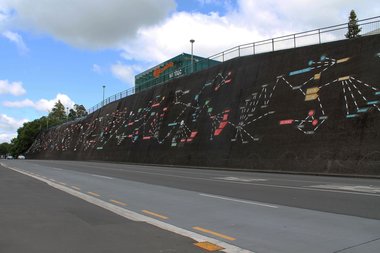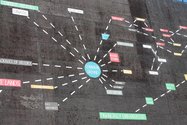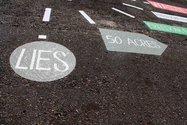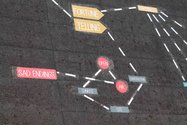Peter Dornauf – 18 November, 2012
What is presented, read left to right, is a sort of potted history lesson of Hamilton and by extension, New Zealand too, starting with references to colonial times with words like “hauling canoe” and “swamp”. This then branches out with the focus on “Early Days” from which radiate, spoke-like, such terms as, “Imperial outpost”, “redoubt” and “confiscation line”. Toward the end of the wall, the text takes on a more hopeful and conciliatory tone.
Hamilton
Kim Paton
Mind Map
I November 2012 - 30 January 2013
Public art has become a bit of a thing recently in Hamilton, sign of a city struggling to grow up, foot it with the big smokes, shake off the provincial cringe. Various organizations have spontaneously popped up in the last year or so to promote and erect public sculpture. One of them, MESH, a philanthropic arts group, is erecting at the moment its first sculptural commissioned piece, created by New Zealand artist, Seung Yul Oh.
While this has been happening, Kim Paton, Wintec School of Media Arts tutor, has been busy installing Mind Map, a collaged selection of words and phrases along a large concrete stretch of wall in Anglesea Street, Hamilton, just down from Wintec itself. The wall is 400 meters long and 50 meters high at its tallest point, which must make the installation the largest temporary art construction ever created in New Zealand, while the concept of mind mapping was invented by British psychologist Tony Buzan in the early seventies.
The wall itself is a product of a works scheme project, late depression era, which involved the removal of half a hill in the middle of the city in 1939. Beautiful period villas had to be removed or demolished in the process, leaving a large flat area for car parking space (what else) and a massive concreted retaining wall that over the years has formed a black patina, creating a readymade canvas. That sprawling surface has seen, over the last few years, dribbles of paint intermittently poured down from the crest to create some pathetic visual interest, but nothing on the scale to match Paton’s audacity.
New Zealand art and the imperative of text, has had a clear history that reaches back to Colin McCahon and his call about needing words. A decade before Lichtenstein began using speech bubbles courtesy of the comic book narrative, McCahon’s late forties crucifixion scenes was employing them in the same fashion, borrowing from an ad on the back of a Rinso packet. “Washes white, sunshine bright”, became “This is Jesus, King of the Jews.”
Our predilection for text in our art has continued since then with practitioners as diverse as Shane Cotton, Fiona Pardington, Peter Robinson, Dick Frizzell, Nigel Brown and John Reynolds.
It’s with the latter that Paton, in her project, has the most affinity with. But where Reynolds crowds his composition and plays with word construction itself, creating humorous and quirky neologisms, Paton goes for Buzan’s more diagrammatic look, a kind of lesson plan or brain storm configuration; hence the title. There’s also less fragmentation and chance notation in Paton’s work than Reynolds’, even though the sequence begins with the word “fracture”.
What is presented, read left to right, is a sort of potted history lesson of Hamilton and by extension, New Zealand too, starting with references to colonial times with words like “clearing track”, “hauling canoe” and “swamp”. This then branches out with the focus on “Early Days” from which radiate, spoke-like, such terms as, “Imperial outpost”, “redoubt” and “confiscation line”. Toward the end of the wall, the text takes on a more hopeful and conciliatory tone, employing the words, “diversity” and “opportunity”.
The work itself as a whole was touted as a collaborative effort with public participation and input solicited by Paton via a website where people were encouraged to submit their own words and phrases for inclusion in the final piece. From there it was a process of editing and arranging the text. Thousands of words, some of Paton’s own included, were whittled down to about 800 that made the final cut. The public, in a sense, were helping to create their own unique art work. Democracy in action.
Viewing is best from the opposite side of the street, simply because of the size of the work. Patrons are forced to walk along the footpath to take it all in, a strategy also employed by McCahon. Fortuitously, the site is located opposite a light industrial complex that continuously pumps out hot air from a grill and the spot has become a favourite haunt for the homeless who gather to enjoy free heating of a night. Now they also have art at no cost to contemplate on a cool evening. One can only guess what words and phrases might cause certain introspection. Perhaps “Real Estate” or “camping”. Perhaps even, “lost souls”.
A local firm has provided an external grade vinyl adhesive in various colours (green, red, yellow, grey and blue). Durability in all weathers will be tested over the next three months before it’s taken down.
As a piece, this is not a modernist McCahon, nor Jesus or anyone else calling Elias for help, but religion does get a mention in a citation under “blind” and “bad”. In the main, it is history and politics that feature heavily in this massive visual aid to serious thought, prodding the viewer, as Paton points out, rather than being directive, to think about place, the past, the future as well as the present in order to make us a “civilized race”.
Peter Dornauf








 Advertising in this column
Advertising in this column Two Rooms presents a program of residencies and projects
Two Rooms presents a program of residencies and projects



This Discussion has 0 comments.
Comment
Participate
Register to Participate.
Sign in
Sign in to an existing account.